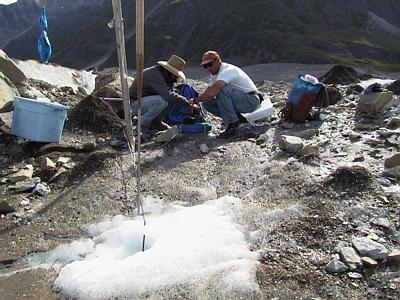
|
|
20 July, 1999
July 20
This morning, grad student Don Lindsay, PI Andrew Fountain and I loaded up
the borehole video camera equipment onto a pack board and hiked out to the
drill site. We were going to view the inside of the borehole, this time
without water. We were going to look for a mechanism from which the
drainage of water from the hole had occurred. When we arrived at the hole,
its diameter was smaller. Why?
The borehole video camera epitomizes the elegance of modern technology. It
is small, compact, and easy to use. The lens/camera is the size of a golf
ball. It is ringed with bright red LEDs, (light-emitting diodes) which
provide light. Two hundred meters (about 600 feet) of triaxial video cable
separates this lens from the video recorder and power supply. Triaxial
means that there are three wires within the cable. All of them are nested.
The central wire is a single, heavy gauge copper wire which transmits images
into the video recorder, which in this case is a hand-held digital
camcorder. The camcorder has a 3x5-inch LCD display from which images can
be viewed. The central wire is surrounded by insulation, which is wrapped
with a braided, fine-gauged copper wire. This "layer" is also wrapped in
insulation, around which is another braided, fine-gauged copper wire. These
outer layers of fine-gauged wire are connected to a 12-volt power source.
Once the 12-volt power supply is engaged, the borehole camera begins
returning a signal to the camcorder.
These data from the borehole camera do not help in quantifying the dynamics
of glacier response to the outburst flood. However, the images enhance a
picture of what is occurring within the borehole. We observed numerous
fractures running across the borehole. This was expected. From a
structural mechanics perspective, the borehole represents a weakness in the
ice. Local stress within the ice will be concentrated at this location,
from which new fractures will emanate. It is similar to ripping a piece of
paper which has a notch along one of its edges. A new tear in the paper
will originate at the notch, which represents a weakness in the structural
properties of the paper.
In addition to fresh fractures, we observed what was inferred to be an
englacial conduit, which is a channel within the glacier which drains water.
It appeared as a cavity in the sidewall of the borehole. In this
instance, there was no water flowing into or out of the conduit. Pebbles
and sand were resting on a ledge at the mouth of the cavity. It was
interesting to be viewing the interior plumbing of a glacier.
At the beginning of this journal entry I asked a question. Why would the
diameter of the borehole be getting smaller? The answer is that no one
really knows. But there has been lively discussion about various
hypotheses. One idea was that the movement of the glacier is squeezing the
hole shut. This happens to most openings in glaciers. However, the hole
was closing faster than expected, and the hole was retaining its round
shape. If being squeezed shut, one would expect the shape of the hole to
become elliptical. The other idea was that melt water was running down the
sides of the glacier and freezing to the walls. The problem with this
hypothesis is that temperate glaciers are typically at the melting/freezing
point of water (0 degrees celsius) during the summer. With an air
temperature above zero celsius, they are usually melting out water, and not
freezing water. However, it was suggested that since the lake had drained,
this portion of the glacier was under tension - it was being stretched and
bent much like a diving board when someone stands on its end. The numerous
fresh fractures around the drill site supported this notion. The freezing
point of water is higher when under conditions of reduced pressure.
Therefore, with an elevated freezing point, meltwater inferred to be at zero
degrees celsius flowing down the side of the hole would encounter freezing
conditions. The question at present remains unanswered. This happens when
doing research. While engaged in the main objective of the study, many
other observations and questions present themselves. Sometimes the answers
to these questions are simple. Sometimes pursuing the answer involves more
research. There is no finality to the conclusions that come about as the
result of science research.
_______________________________________________________________
Get Free Email and Do More On The Web. Visit http://www.msn.com

PI Andrew Fountain and PSU grad student Don Lindsay pore over the video recorder and LCD monitor. A special camera is attached to the end of the video cable which extends into the hole and, in this case, to a depth of 88 meters.

Video recorder with LCD display monitor shown. The monitor allowed real-time viewing of the interior of the borehole.

Contact the TEA in the field at
.
If you cannot connect through your browser, copy the
TEA's e-mail address in the "To:" line of
your favorite e-mail package.
|
